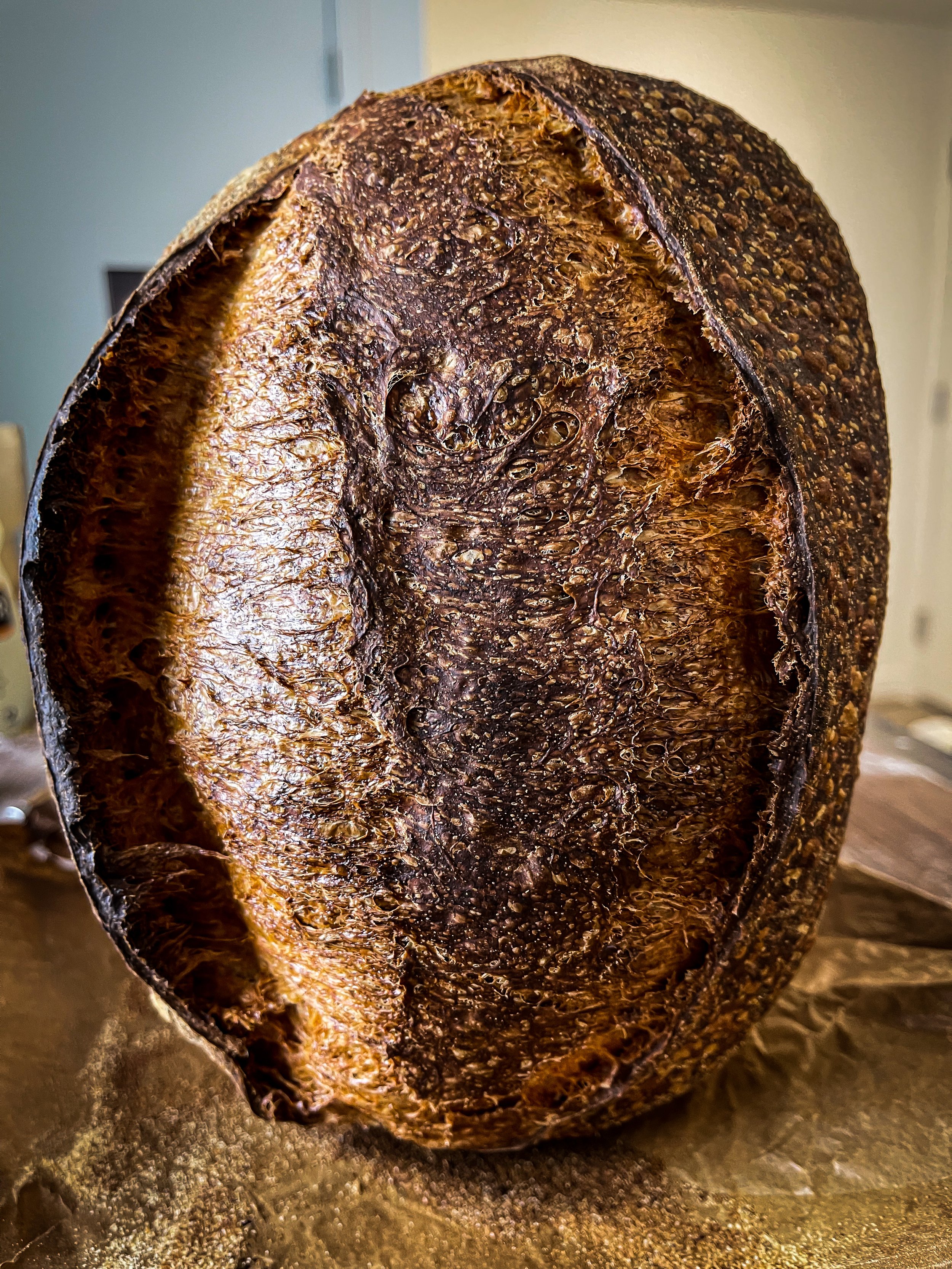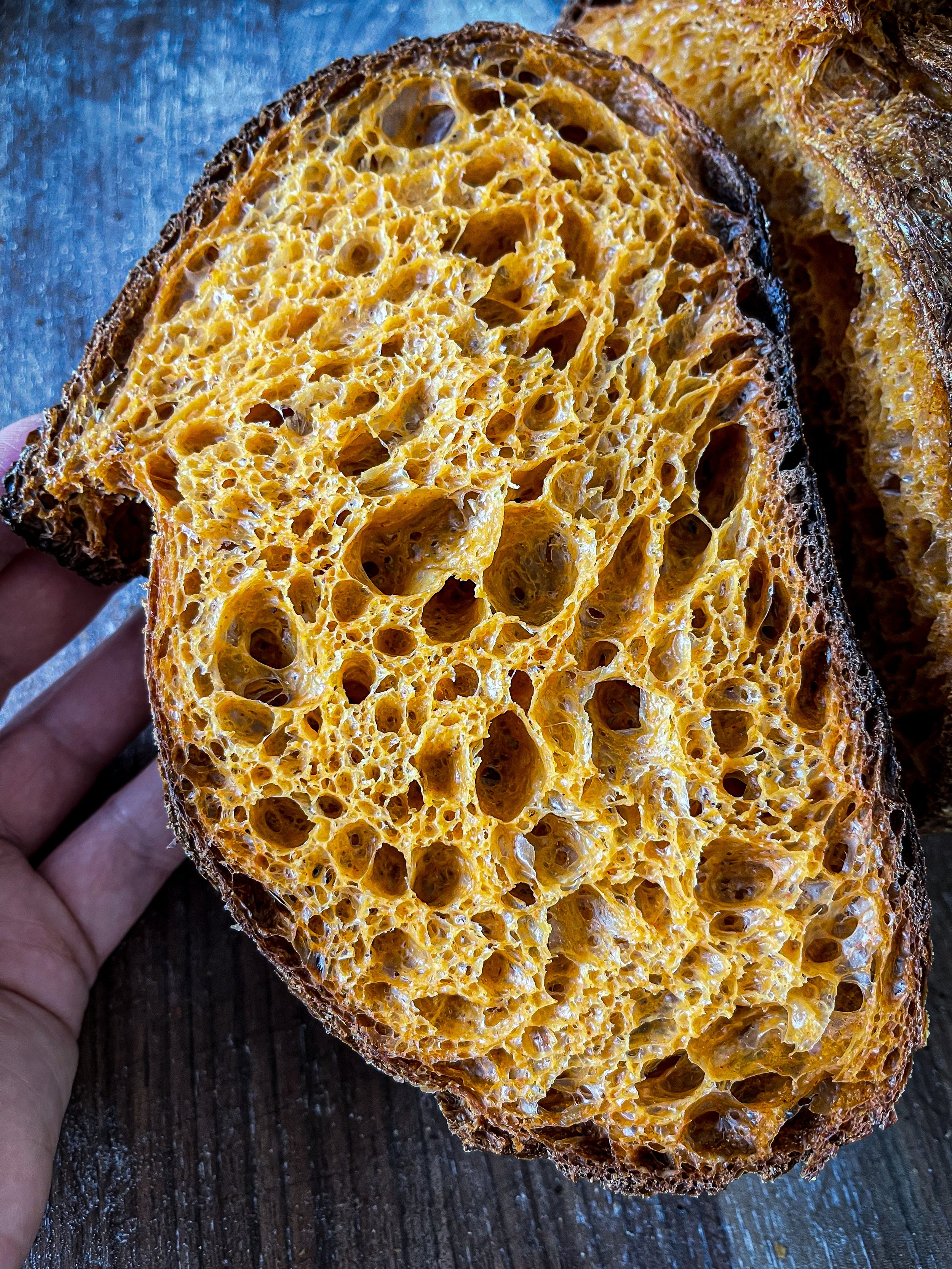Call me a crumb-snob…
…and I would proudly wear that badge. I don’t know about you but I am always criticizing myself and push for more. Work really hard at something, and see what’s gonna happen, is my understanding of things. That’s how I approach my sourdough baking.
I am going to talk to you about this paprika sourdough that I baked the other day, and before I begin, I’d like to say that this bread turned out very good…BUT it could be better! What’s wrong with that? Nothing! If you see its potential why not explore it to the max?!
I’m usually a minimalist but when it comes to sourdough, I want more. I just can’t bring myself to keep it simple. And easy. Because in my opinion, there’s nothing simple about sourdough.
So, about this loaf…
Not long ago, I shared another paprika loaf and talked about how paprika affects the gluten and the final crumb. You can read all about it here.
Because of the effects paprika has on the dough, I added only 1% salt for my previous paprika sourdough. That helped open up the crumb since paprika tightens it a little. Just like cocoa does.
Since for this loaf I added an egg as part of the hydration, I followed the standard 2% salt inclusion. The egg brings extra softness and delicacy to the crumb, it makes it kind of fragile, that’s how soft it is, adding that standard amount of salt brought stability and strength to the dough. That’s what salt does.
I added a little more paprika for this loaf and my egg was very vibrant amber color, and that showed in the final result. It turned out very bright and happy-making.
When I lifted the lid of my baking vessel after the first twenty minutes, I saw the beautiful and defined ear, and I knew that my first intentions were right. And they were that I could’ve extended bulk fermentation a little longer like I had planned.
It doesn’t necessarily mean that if you got the ear, your crumb would be open. Or that it would be open to the degree you wanted to.
I talk in detail about the connection between the bread ear and under/over fermentation in my upcoming book.
Hung up on the ear
More often than you think, the sharp and well expressed bread ear indicates under fermentation. And not just the well formed ear but also there’s a second layer from where the bread opens and peels where it’s been scored. That also indicates under fermentation. As you can see here, look closely, and you will spot that second layer of peeling.
Very often, fermentation is not even through out the bread, which also tries to tell you that it needed longer bulk fermentation.
For this paprika sourdough, all three indicators are here to tell me that the dough needed to ferment even better to get to that lacy quality of the crumb that I’m looking for.
Saying that often times fermentation is not even through out the bread, means that, for example, when you slice your bread right in the center, the crumb might appear a little tighter. Then the next slice could be better, with better fermented crumb. You’ll notice that if you pay close attention. Which is the case here. The first photo is the one from the center slice and there are two spots of slightly tighter crumb. Do you see them?
Next photo is from the second slice and it’s better. And it got more beautiful with each slice, better quality fermentation for sure. Do you see it?
Because of the added egg as part of the hydration, this loaf could’ve fermented a little longer, the egg brings strength to the dough(more protein) and the dough needs and can handle long fermentation without a problem. Bulk was 9.5h at 72-75F and an additional hour shaped in the bannetone, left at 75F, and it could’ve easily be 11h. Of course with the understanding that you might not get as defined ear as you wanted to.
If you must chase the ear, you can definitely achieve it, if everything is done right, you can get your ear and open crumb too. As you know there are so many variables in sourdough baking, that’s why I can’t treat it in a simple, fast and easy way.
My doughs are always high maintenance but you know what, I like maintaining them.
So, this loaf has both, the ear and the open crumb. But….the quality of the crumb I am looking for is not entirely there. It’s perfectly fine the way it is, and I appreciate it. But because I am looking for a more advanced degree of fermentation, I need to work on it and make it again with an extended bulk fermentation even if it’s just additional 30min.
If I have to compare both of my paprika loaves, I’d say that the first one, where I added only 1% salt, is better fermented. You can see the difference yourself. Bulk fermentation there was 8.5h, which was enough time for the dough to ferment well because I added less salt. That speeds up fermentation. An egg slows it down.
The very purpose of this post is to share knowledge, to encourage ambition and pursuit of hard work, and understanding of levels of fermentation.
Are you going to judge sourdough by the ear or by the crumb?
STEP BY STEP METHOD
INGREDIENTS:
350g bread flour
20g paprika
253.5g water+51g egg(total hydration 87% or 304.5g
70g starter
7g salt
Mix flour, paprika and water+egg in a bowl
Do an autolyse. Mine was 40min but as you know, I love long autolyse and when I have time, I prefer extending it at least for few hours
After autolyse, add the starter and mix well to incorporate it well. I mixed for 2-3min, rest for 5-7min and then mixed additional 1-2min. My starter was 14h old here. Meaning 14h after feeding it. From my book you’ll learn how I manage to use very mature starter with success.
Cover and let it rest for 30min
Add the salt. Mix well to incorporate it. I mixed for 2-3min.
Cover and let it rest for 30min
Do one lamination
Fold the dough, transfer it to a bulking dish and let it rest for 30-40min. Mine was left to rest for 45min before I did the first coil fold
Perform as many coil folds as needed. Mine were total of 4 coil folds separated by 45min. Watch the dough and observe how relaxed it gets in between folds. Do additional folds if needed. Even with the high hydration of 87%, this dough maintained good shape because of the paprika and the egg, which both absorb lots of water.
After the last coil fold, let the dough finish bulk fermenting. Give it time to ferment well. We have an egg here, it will take longer. Watch the dough, not the clock! My bulk fermentation was 9.5h at 72-75F. For the first few hours, up to the moment where I transferred the dough to a bulking dish, the dough was kept at 72F and after that at 75F.
Shape your dough and retard it in the fridge. I left my loaf for 1h at 75F in the bannetone before I put it in the fridge for 12h cold proof.
Score and bake. Bake straight from the fridge in your chosen vessel.







